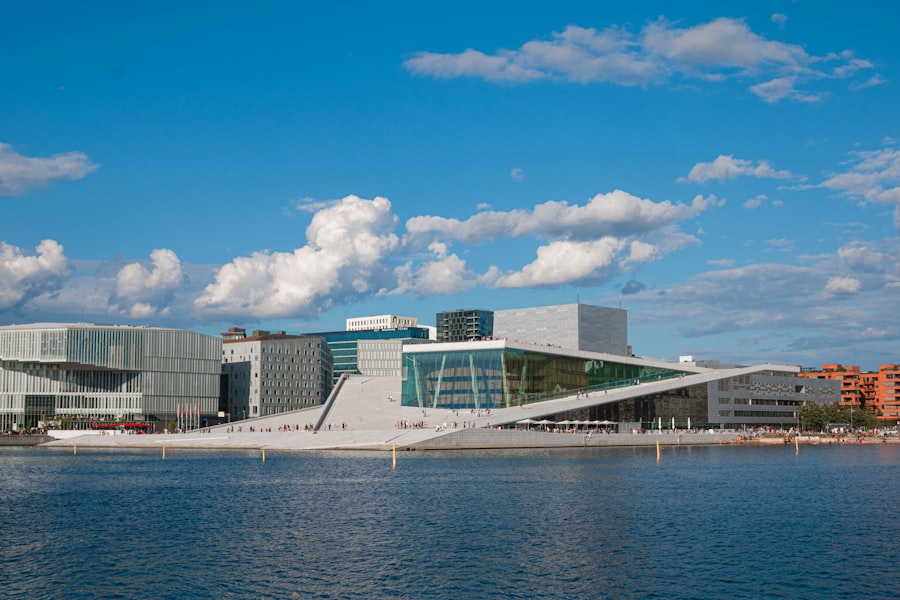In recent years, the demand for storage units in Norway has surged, driven by various factors that necessitate additional space for personal belongings. The country’s urban areas, particularly Oslo, have seen a significant increase in population density, leading to smaller living spaces. As people downsize their homes or move into apartments, the need for extra storage becomes apparent.
Whether it’s seasonal items, furniture, or personal effects that are no longer needed on a daily basis, a storage unit provides a practical solution to manage clutter and maintain a tidy living environment. Moreover, the transient nature of life in Norway, with many individuals relocating for work or study, has further contributed to the popularity of storage facilities. Students moving to Oslo for their studies often require a place to store their belongings during summer breaks or when they travel.
Similarly, expatriates may find themselves needing temporary storage while they transition between homes. In such scenarios, renting a storage unit offers flexibility and peace of mind, allowing individuals to keep their possessions safe until they are ready to retrieve them. Take the first step. Book a consultation with the Norway Relocation Group for your move to Norway. https://norwayrelocation.no/one-hour-strategy-session/
Summary
- Renting a storage unit in Norway can be necessary for decluttering, downsizing, or storing seasonal items
- Research and choose a storage facility based on location, security, and access options
- Determine the size of the storage unit needed by assessing the quantity and size of items to be stored
- Understand the costs and fees associated with renting a storage unit, including rental fees, insurance, and any additional charges
- Secure a rental agreement and insurance for the storage unit to protect stored items and ensure peace of mind
Researching and Choosing the Right Storage Facility
When it comes to selecting a storage facility in Norway, thorough research is essential. The first step is to identify the various options available in your locality. Many companies offer a range of services, from climate-controlled units to outdoor storage spaces.
It is crucial to consider what type of items you plan to store, as this will influence your choice of facility. For instance, if you have delicate items that require specific temperature conditions, opting for a climate-controlled unit would be wise. Additionally, reading reviews and testimonials from previous customers can provide valuable insights into the reliability and quality of service offered by different storage facilities.
Websites and social media platforms often feature feedback that can help you gauge the reputation of a company. Furthermore, visiting potential facilities in person can give you a better sense of security measures in place, cleanliness, and overall accessibility. Engaging with staff members can also clarify any questions you may have regarding their services and policies.
Determining the Size of the Storage Unit Needed

Choosing the right size for your storage unit is a critical step in the process. Storage facilities typically offer a variety of unit sizes, ranging from small lockers to large garage-like spaces. To determine what size you need, it is advisable to make an inventory of the items you plan to store.
This list should include furniture, boxes, appliances, and any other belongings that will occupy the space. Once you have a comprehensive inventory, consider how you will arrange these items within the unit. It is often beneficial to opt for a slightly larger unit than your calculations suggest; this allows for easier access and organisation of your belongings.
Additionally, if you anticipate acquiring more items in the future or if you are unsure about what you might need to store later on, erring on the side of caution with size can save you from having to rent another unit down the line.
Understanding the Costs and Fees Associated with Renting a Storage Unit
The costs associated with renting a storage unit can vary significantly based on several factors including location, size, and additional services offered by the facility. In Norway, it is common for storage companies to charge monthly fees, which can range from affordable rates for smaller units to higher prices for larger or climate-controlled spaces. It is essential to factor in these costs when budgeting for your storage needs.
In addition to monthly rental fees, potential renters should be aware of other associated costs such as administration fees, security deposits, and insurance premiums. Some facilities may also charge for access outside of regular business hours or offer additional services like packing supplies or transportation assistance at an extra cost. Therefore, it is prudent to read the fine print of any rental agreement carefully and ask questions about any unclear charges before committing to a facility.
Securing a Rental Agreement and Insurance for the Storage Unit
Once you have selected a suitable storage facility and determined the size of your unit, the next step is to secure a rental agreement. This document outlines the terms and conditions of your rental, including payment schedules, access hours, and responsibilities regarding maintenance and security. It is vital to read this agreement thoroughly before signing; understanding your rights and obligations will help prevent misunderstandings later on.
In addition to securing a rental agreement, considering insurance for your stored items is highly advisable. While many storage facilities offer basic insurance coverage as part of their service, this may not be sufficient for high-value items. Therefore, it may be worth exploring additional insurance options through your home insurance provider or purchasing separate coverage specifically for your stored belongings.
This added layer of protection can provide peace of mind knowing that your possessions are safeguarded against unforeseen events such as theft or damage.
Organizing and Packing Items for Storage

Effective organisation and packing are crucial when preparing items for storage. Properly packing your belongings not only maximises space but also protects them from potential damage during transit and while stored. Begin by gathering packing materials such as sturdy boxes, bubble wrap, packing tape, and labels.
It is advisable to use uniform box sizes where possible; this makes stacking easier and more stable within the unit. When packing items into boxes, it is important to label each box clearly with its contents and the room it belongs to. This practice will save time when retrieving items later on.
Additionally, disassembling larger furniture pieces can create more space and make transportation easier. For fragile items, wrapping them individually in bubble wrap or packing paper will help prevent breakage. Finally, consider creating an inventory list that details all packed items; this will serve as a useful reference when accessing your storage unit.
Transporting Items to the Storage Facility
Transporting your belongings to the storage facility requires careful planning to ensure everything arrives safely and efficiently. If you have access to a vehicle large enough to accommodate your items, this may be the most straightforward option. However, if you are dealing with larger pieces of furniture or numerous boxes, hiring a removal service could be beneficial.
Many companies in Norway specialise in transporting goods to storage facilities and can provide assistance with loading and unloading. When loading items into your vehicle or removal truck, it is essential to pack strategically. Heavier items should be placed at the bottom of the load to prevent lighter items from being crushed during transport.
Additionally, securing everything with straps or blankets can help prevent shifting while on the road. Once you arrive at the storage facility, take care when unloading; using dollies or hand trucks can make this process much easier and reduce the risk of injury.
Utilizing and Accessing the Storage Unit Efficiently
Once your belongings are safely stored away in your chosen unit, utilising that space efficiently becomes paramount. A well-organised storage unit not only makes it easier to find what you need but also maximises the available space. Start by placing frequently accessed items near the front of the unit; this way, you won’t have to dig through boxes every time you need something.
Consider using shelving units or stacking boxes vertically to make use of vertical space effectively. Clear plastic bins can also be advantageous as they allow you to see contents without having to open each box. Additionally, leaving pathways between boxes can facilitate easy access and help maintain an organised environment within your unit.
Maintaining and Monitoring the Stored Items
Maintaining your stored items is essential for ensuring they remain in good condition throughout their time in storage. Regularly checking on your belongings can help identify any potential issues before they escalate into significant problems. Depending on how long you plan to keep items in storage, consider visiting your unit periodically—this could be monthly or quarterly—to inspect for signs of moisture damage or pest infestations.
If you are storing items long-term, it may be wise to invest in moisture absorbers or dehumidifiers if your unit lacks climate control features. Additionally, keeping an inventory list updated will help track what you have stored and make it easier to manage your belongings over time.
Understanding the Rules and Regulations of the Storage Facility
Every storage facility has its own set of rules and regulations that tenants must adhere to while renting a unit. Familiarising yourself with these guidelines is crucial for ensuring compliance and avoiding potential issues during your rental period. Common regulations may include restrictions on what types of items can be stored (e.g., hazardous materials), access hours for tenants, and policies regarding subletting or sharing units.
It is advisable to ask facility management about any specific rules that may apply during peak seasons or holidays when access might be limited due to increased demand. Understanding these regulations not only helps maintain a good relationship with facility staff but also ensures that you are fully aware of your rights as a tenant.
Tips for Making the Most of Your Storage Unit Rental in Norway
To maximise your experience with a storage unit rental in Norway, consider implementing some practical tips that can enhance efficiency and convenience. First and foremost, always keep an updated inventory list handy—this will save time when searching for specific items later on. Additionally, take advantage of vertical space by stacking boxes securely; this not only optimises space but also keeps everything organised.
Another useful tip is to utilise clear bins instead of opaque boxes whenever possible; this allows you to see contents at a glance without having to open each container. Furthermore, consider using furniture covers or protective wraps for larger items like sofas or mattresses; this will help keep them clean and free from dust while in storage. Lastly, don’t hesitate to communicate with facility staff if you have any questions or concerns about your rental agreement or stored items; they are there to assist you and ensure that your experience is as smooth as possible.
In conclusion, renting a storage unit in Norway can provide an invaluable solution for managing personal belongings amidst changing living situations or lifestyle needs. By understanding the various aspects involved—from selecting the right facility to efficiently utilising your space—you can ensure that your experience is both positive and productive. Whether you’re storing seasonal gear or transitioning between homes, taking these steps will help safeguard your possessions while providing peace of mind during times of change.
Learn more about the Norwegian classes at the NLS Norwegian Language School in Oslo

